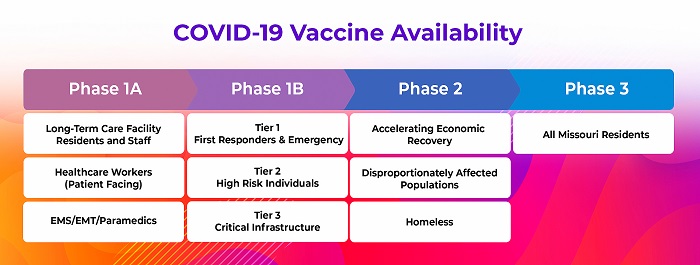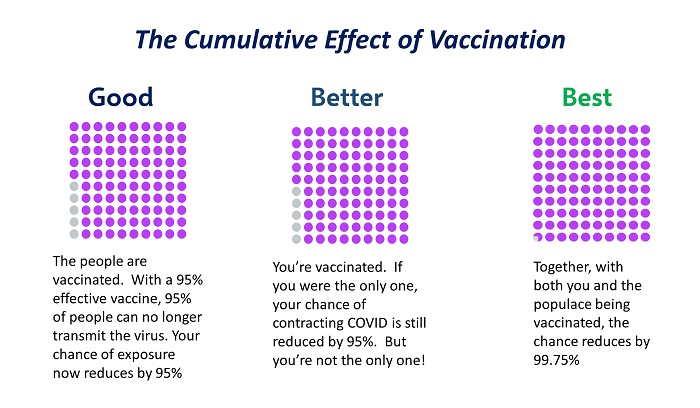
At last, the COVID-19 vaccines are here! For us now, this only includes the Pfizer- and Moderna-produced vaccines. Missouri is prioritizing our vaccinations based on someone’s assessed health risk. To do this, our state is grouping its citizens into four categories, with people receiving their inoculations during four distinct phases.

Included in Phase 1B, Tier 2, “High-Risk Individuals,” is anyone 65 and older. This tier also consists of individuals with weakened immune systems from cancer, Chronic Kidney Disease, COPD, Heart Conditions, Type 2 Diabetes, etc. For specifics, visit Missouri’s web site: https://covidvaccine.mo.gov/.
Since you may be over 65, you can go online to https://covidvaccine.mo.gov/map/ to find a vaccination-location site. When writing this article, the closest places to Kimberling City are Walgreens Pharmacy and Walmart, both in Branson West.
About the Vaccines
Right now, Missouri is only administering vaccines from Pfizer and Moderna. To test for safety and effectiveness:
- Pfizer included more than 44,000 participants in its trials.
- Moderna had 30,000 trial participants.
The most common side effects for both vaccines are pain, swelling, and redness at the injection site. Some may also experience headache, chills, and tiredness.
Both are about 95% effective in preventing someone from contracting COVID after achieving optimum immunity. However, this requires two doses. How long you wait for the second dose varies. For:
- Pfizer, the second shot should be administered 21 days later.
- Moderna, the waiting period is 28 days.
After the second dose, you’ll reach optimal immunity anywhere from seven to 10 days later.
Was Ist Das?
Based on available data, ten days after your second vaccine shot, your chances of getting sick from COVID are reduced by 95%. Another benefit of being vaccinated is the vast reduction of potential COVID transmitters. With fewer people around who can transmit the disease (potentially reduced up to 95%), the aggregate effect will be even more significant.
Let’s extrapolate a bit.

What does this mean for Shepherd of the Hills Lutheran Church?
Once we achieve “critical mass,” we can start relaxing our COVID practices since we will no longer need them. Rest assured, we will wait for the “okay” from our health authorities since they have the bigger picture.
So far, no one has contracted COVID at church since all this began almost a year ago. So, our COVID-prevention procedures are working. These practices include, but are not limited to:
- Providing masks for those who want to wear one,
- physical distancing,
- continually circulating air through ceiling fans and heating/cooling systems,
- pastor and elder wearing masks, face shields, and gloves during Communion,
- and controlled entry and exits.
Soon, Lent will here. If you’ve been staying home out of health concerns, consider coming to the midweek Lenten services. These can serve as a gradual reintroduction into coming back to church. Attendance is less during these services, so maintaining your physical distance is easy.
Here are a few other protective measures you can follow:
- Put on a provided mask when making your way to where you will be sitting. Make sure you sit at least six feet away from those outside your household.
- Sit several feet away from the center aisle since that is the only way we enter and exit the sanctuary.
- Once situated, remove your mask. The mask is most effective when dry. So, save your mask and wear it when you need it: when you are near another person.
- Where your mask when exiting.
During our midweek services, you’ll have to go out of your way to try to catch COVID. But let’s suppose you try and violate the space of two other people. Oh, let’s assume those two people are bad boys, as well, and they came in contact with two other people during the week. What’s the risk now? Based on COVID data from Stone County, your estimated probability of being exposed to COVID-19 is 0.029% (https://19andme.covid19.mathematica.org/).
Oops, but you forgot to take off your mask! According to UC-Davis, properly wearing a mask reduces contracting COVID by 65% (https://www.ucdavis.edu/coronavirus/news/your-mask-cuts-own-risk-65-percent/). Now the statistical probability drops to .01%.
Of course, you’re not a bad boy, and you want what’s best for your neighbor. So, you followed our congregational and COVID protocols. What’s the risk now? So low that if you can calculate that, you deserve a Nobel Peace Prize in mathematics.
Your pastor is not yet 60 (and you thought he was an old geezer!). So, he’s not in an at-risk health category and won’t receive vaccination until later. Nevertheless, he’ll continue to follow all needed precautions to help keep others safe. Though you might soon be immune, you still might see him all “masked up” during parts of the worship service.
Ten days after you receive your second COVID injection, consider resuming your “pre-COVID” life. Who knows, you may pass this 10-day mark before Easter. If so, how wondrous! At that point, we may all feel we, too, have risen—from quarantine, that is, and given a new lease on life. And if not on Easter Day, of course, at the resurrection of all flesh. Amen.

